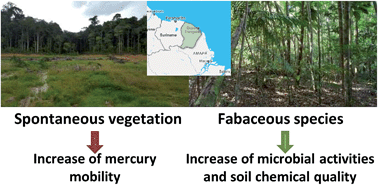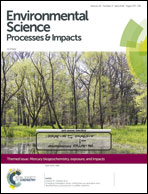Mercury behaviour and C, N, and P biogeochemical cycles during ecological restoration processes of old mining sites in French Guiana
Abstract
Several decades of gold mining extraction activities in the Amazonian rainforest have caused deforestation and pollution. While ecological rehabilitation is essential for restoring biodiversity and decreasing erosion on deforested lands, few studies note the behaviour or toxicity of trace elements during the rehabilitation process. Our original study focused on the potential use of microbial activity and Hg speciation and compared them with As, Cu, Zn and Cr speciation in assessing the chemical and biological quality of ecological restoration efforts. We sampled two sites in French Guyana 17 years after rehabilitation efforts began. The former site was actively regenerated (R) with the leguminous species Clitoria racemosa and Acacia mangium, and the second site was passively regenerated with spontaneous vegetation (Sv). We also sampled soil from a control site without a history of gold mining (F). We performed microcosm soil experiments for 30 days, where trace element speciation and enzyme activities (i.e., FDA, dehydrogenase, β-glucosidase, urease, alkaline and acid phosphatase) were estimated to characterise the behaviour of trace elements and the soil microbial activity. As bioindicators, the use of soil microbial carbon biomass and soil enzyme activities related to the carbon and phosphorus cycles seems to be relevant for assessing soil quality in rehabilitated and regenerated old mining sites. Our results showed that restoration with leguminous species had a positive effect on soil chemical quality and on soil microbial bioindicators, with activities that tended toward natural non-degraded soil (F). Active restoration processes also had a positive effect on Hg speciation by reducing its mobility. While in Sv we found more exchangeable and soluble mercury, in regenerated sites, Hg was mostly bound to organic matter. These results also suggested that enzyme activities and mercury cycles are sensitive to land restoration and must be considered when evaluating the efficiency of restoration processes.

- This article is part of the themed collection: Mercury Biogeochemistry, Exposure, and Impacts


 Please wait while we load your content...
Please wait while we load your content...